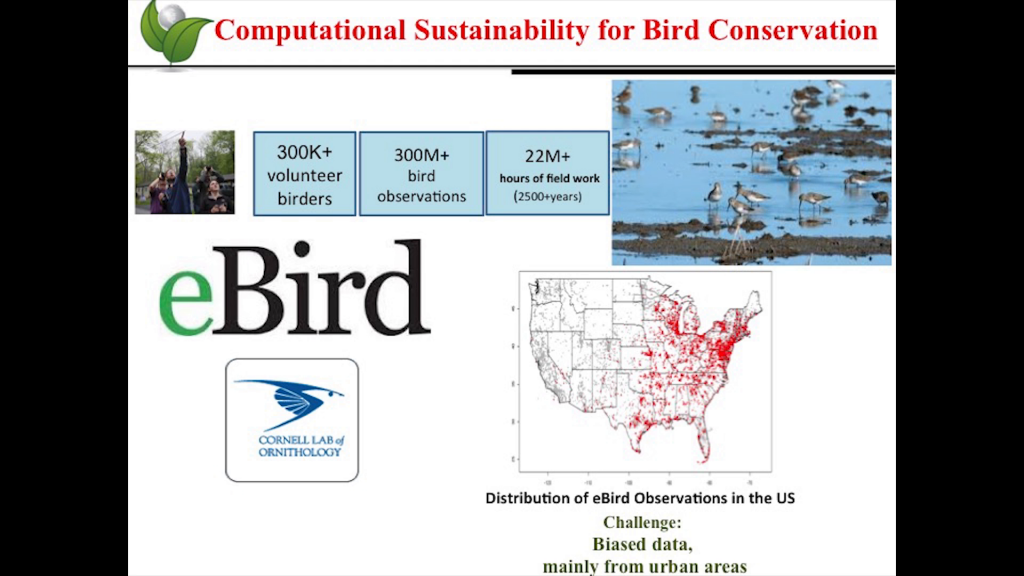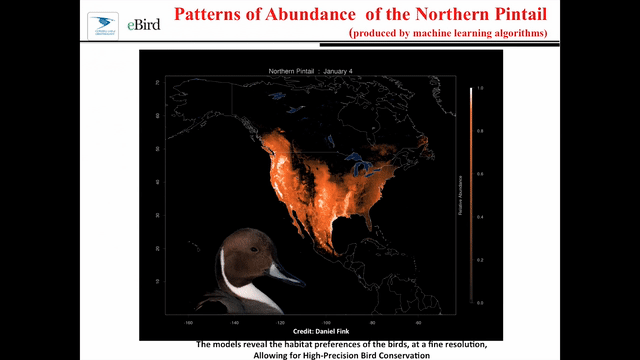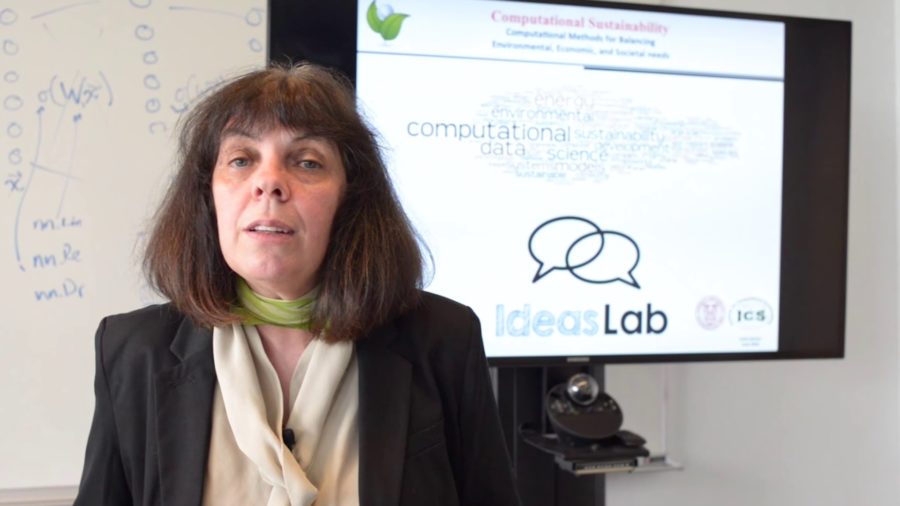Today I hope to give you the big vision behind the new interdisciplinary field of computational sustainability pioneered at Cornell. Computers and computational thinking have revolutionized our lives. The smartphone is the ultimate example of a universal computer. Apps transform the phone into different devices. Unfortunately, the computational revolution has done little for the sustainability of our Earth. Yet, sustainability problems are unique in scale and complexity, often involving significant computational challenges.

Here is an example of a computational sustainability approach for bird conservation. eBird is a citizen science program with over 300,000 volunteer birders who have submitted over 300,000,000 bird observations corresponding to more than 2,500 years of field work. This is exciting, but the challenge is that the data are often biased, mainly from urban areas.
To incentivize birders to visit undersampled locations, we developed a game, Avicaching, using game theory. Birders accrue Avicaching points toward a lottery for binoculars and other prizes. The points are assigned to locations based on the birders’ behavior, to induce a more uniform distribution of bird observations.
This has been a very successful game, shifting birders to undersampled locations. We combined the eBird data with environmental data, lots of data, and using advanced spatial and temporal machine learning models, and high-performance computing, we are able to relate the environmental predictors with the patterns of occurrence and absence of the species.

This animation shows the patterns of abundance of the northern pintail for different months of the year, produced by the machine learning models. The models reveal at a fine resolution the habitat preference of the birds, which allows for novel approaches for bird conservation.
A good example of high-precision conservation is bird returns, a program of The Nature Conservancy with the goal of protecting migratory waterbirds in California against the drought. The eBird models identified the target areas of the bird migration in Sacramento Valley that are provided to The Nature Conservancy. Farmers submit bids to The Nature Conservancy to keep the target rice fields flooded in order to provide habitat for the birds during the bird migration.
This big data analytics and market-based approach has generated over twenty thousand acres of additional habitat for waterbirds in California. This is a radically novel way of doing bird conservation. It is only possible because we use advanced computational methods for high-precision conservation.
Computational sustainability aims to develop cross-cutting computational approaches. Findings can be transferred across domains. This has been a key driving force behind the dramatic advances in information and computation technology, just like the universal computer. For example, the game theory model used for Avicaching is also used to decide where to place patrols to prevent poaching and illegal fishing. Computationally, these problems are similar.
We represent these cross-cutting computational themes with colored subway lines. Mechanism design and game theory is the baby blue line. I talked about these circled projects. We have many other computational sustainability projects covering a wide range of application domains and computational themes.
Computational sustainability is a truly interdisciplinary endeavor since computational sustainability encompasses balancing environmental, economic, and societal needs for human well-being, for current and future generations. A key challenge is how to effectively establish the necessary large-scale interdisciplinary projects and collaborations. Computational sustainability aims to advance computational methods to help balance economic, environmental, and societal needs for sustainable development.
Computational sustainability is a two-way street. On one hand it injects computational thinking that provides new insights, methodologies, and solutions to sustainability problems. On the other hand, it leads to foundational contributions to computer science by exposing computer scientists to new challenge problems and new formalisms, and concepts from other disciplines, leading to cross-cutting computational problems in computer science. More importantly, it has tremendous societal impact.
Further Reference
2016 Annual Meeting of the New Champions at the World Economic Forum site
